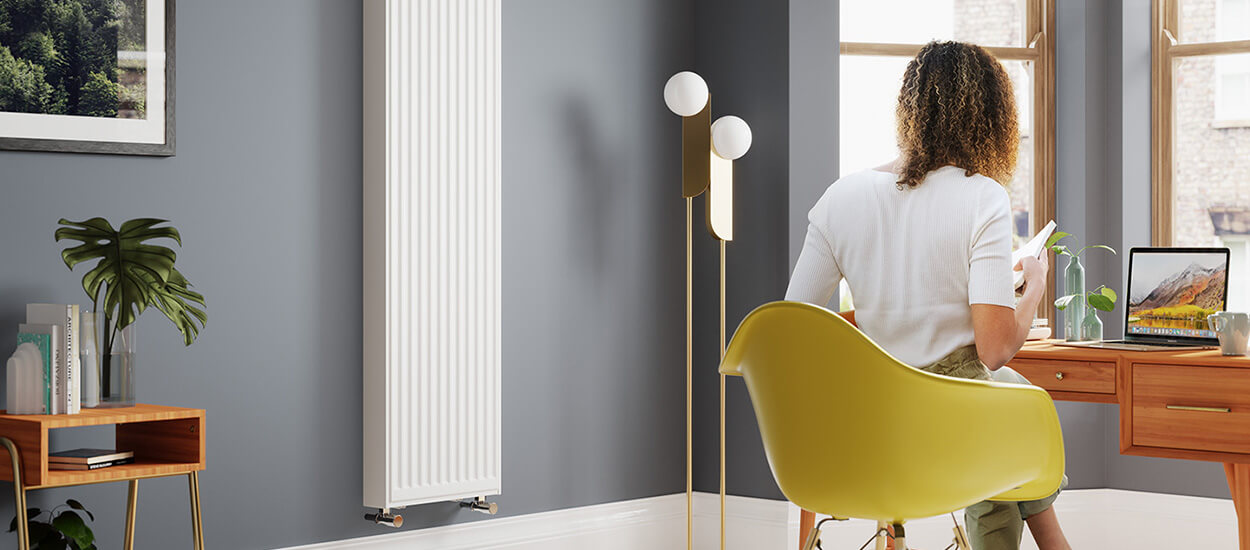Most homes rely on radiators for their main source of heat, but not a lot of people know how these wonderful appliances work. You may know that they work with your central heating, but do you know how they heat up and what all the different valves are for? Knowing how a radiator works can be helpful if you find that they suddenly stop working too, so you’ll know when it’s time to call in the professionals, or if it’s something that’s easily fixed yourself. Keep reading to find out everything you need to know about how a radiator works to keep your home warm and cosy.
How Do Radiators Get Hot?
Radiators heat up the same way no matter which type of central heating system you have. Both gas and electric boilers heat up water that then travels through the pipework and into your radiators. The hot water then causes them to heat up and warm the room. In newly built homes the water remains as it is, whereas in older houses it changes into steam and then condenses into water when the radiators cool down. The water inside your radiators doesn’t stay in them the entire time either. It moves through them via the radiator valves and only stays inside the radiators when they’re turned on. This movement of water through your radiators is key to how a radiator works but can consistently cause air to become trapped, which is why bleeding a radiator is necessary. Trapped air can cause the radiator to not heat sufficiently, so if you discover that its warmth is getting patchy, try bleeding it first.
What Are Radiators Made From?
Radiators are a conductor of heat and the different metals that they’re made from help them to stay warmer for longer. Most metal radiators are made from either mild steel, stainless steel, cast iron, or aluminium. These metals tend to be the best at giving out heat and also retaining it. The type of metal used will also influence how a radiator works, with aluminium designs, for example, able to conduct heat much quicker than traditional steel and also cool down faster.
How Do They Heat The Room?
As the radiator fills with hot water, the heat is forced outwards which then warms the air of the room. This method of heating a room is a closed process and means that you can heat your rooms easily. The heat from the radiator also rises directly up and fills the rooms, so radiators are one of the most effective ways to warm an entire room quickly. The water inside the radiator cools down and then is pushed back through the pipework into the boiler to be reheated. This happens in a continuous cycle for as long as the radiator is on. The water inside a radiator has to flow from the top valve and goes out from the bottom as once the water has cooled down, it will fall to the bottom of the radiator.
What Do the Valves Do?
There are a few different valves on radiators and depending on which type you have, you might have a different set of valves. Essentially, the valves control how much water comes in and out of the radiator and allow you to have even more control over their heating. You’ll normally find the valves near the bottom of the radiator near the pipework so they’re easy to access when needed. There are 3 main types of valves that you’ll find on most radiators in the UK. They are:
- Lockshield Valves
- Manual Valves
- Thermostatic Radiator Valves
Lockshield Valves
These types of valves are on pretty much all radiators and their job is to control the amount of heat the radiator gives out. These valves are also used to balance the radiators as well. These valves are normally locked in place so that their setting doesn’t adjust over time.
Manual Valves
Manual valves allow you to have control over the heat that’s fed to your radiator, and they work in a way that’s similar to a tap. However, it can take a few attempts to get it right, so you may find that the heat isn’t where you want it straight away.
Thermostatic Radiator Valves
These valves control the temperature of the radiator and will automatically change when it’s needed so that the heat is consistent. Thermostatic radiator valves can be more energy efficient too, as their automation means you don’t waste heat.
Balancing Radiators
Balancing your radiators is important if you want to ensure maximum heat is produced by them at all times. The hot water produced by your boiler has to travel through a series of pipes before it reaches the radiator, so naturally, it will lose some heat during the journey. Balancing the radiator allows you to adjust how fast the water travels through these pipes so that if your radiator is far away from the boiler, you can slow down the journey, so you lose less heat.
As they are an essential part of any home, knowing how a radiator works can help you look after them and get the most out of heating each room of your home. Take some time to learn about your radiators, and if you have any questions, please don’t hesitate to get in touch.
To help you work out the correct heat output for the room you are fitting with a radiator, use our BTU heat loss calculator to see which are best based on the features and size of the room.

